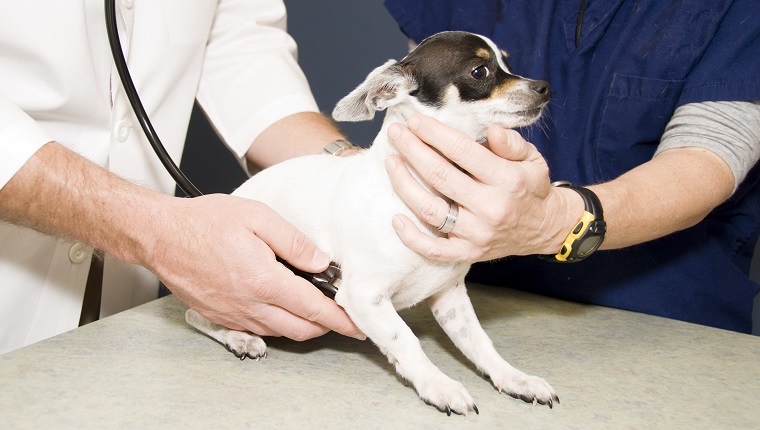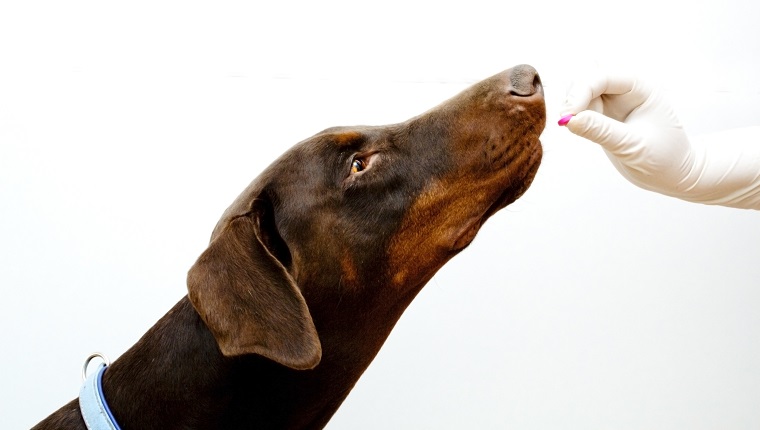“How much Benadryl can I give my dog?” You probably ask this question if your dog suffers from allergy symptoms. Humans use over-the-counter Benadryl to treat allergies all the time, but is it safe to give it to your dog — and if so, how much should you give your pooch?
Fortunately, you can give your dog Benadryl if your veterinarian recommends it, but the correct dosage depends on a few factors. You must consult your veterinarian before giving your dog Benadryl or any other medication, even over-the-counter drugs.
Here’s what you should know about giving Benadryl to dogs.
What Does Benadryl Treat In Dogs?

Benadryl is an over-the-counter antihistamine that calms allergic reactions to environmental allergens, insect bites or stings, and certain vaccine reactions. It has also been used as a sedative and to prevent motion sickness.
Though it is a human drug and not FDA approved for dogs or other animals, it can be given safely with approval from your vet.
Benadryl is the brand name, not the name of the drug that treats allergies. Diphenhydramine is the active drug in the medication that is safe for canines when given in the proper dosage.
There are many other brands that make similar products, and there are other drugs under the Benadryl brand that you must use caution to avoid. Read the ingredients of the medication before giving it to your dog, and ask your vet before giving them any medication.
When Is Benadryl Bad For Dogs?

In some situations, Benadryl can be very harmful to dogs, which is why it’s so important to consult your veterinarian before giving it to your.
Here are a few instances where Benadryl can be dangerous for dogs:
- Medical conditions. Certain conditions, such as glaucoma, heart disease, or high blood pressure, can be worsened by Benadryl.
- Other medications. Other drugs, even those that are over-the-counter, can cause a dangerous reaction when combined with Benadryl.
- Allergic reaction. Ironically, some dogs can have an allergic reaction to Benadryl.
- Side effects. The most common is sedation, but dogs can also experience changes in breathing, heart rate, and urination. Rarely, some may vomit or suffer from diarrhea.
- Different formulas, brands, or products. Read the ingredients. Acetaminophen and pseudophedrine are not safe for dogs, and they are included in some allergy medications. There are many Benadryl products, so ask your vet to make sure you are using the correct one.
- Overdose. An overdose can be fatal. If your dog eats too much Benadryl, call the emergency vet or poison control hotline at (888) 426-4435 right away. Symptoms of overdose include dilated pupils, constipation, rapid heartbeat, behavioral changes, and seizures.
- Pregnant or nursing. Dogs who are pregnant or nursing should almost never be given medication without strict veterinary supervision.
How Much Benadryl Can I Give My Dog?

The general dosage guideline for dogs is 1 mg of Benadryl for every one pound of body weight. You must always consult your veterinarian, as there are a number of factors that can change this dosage recommendation.
The average dosage included in one tablet is 25mg, so a 25-pound dog should be given one tablet. Check the dosage on the package, and don’t assume that every product will be the same.
Stick to the pill form, as the liquid form contains alcohol, which is toxic for dogs.
For small dogs, you may wish to use the children’s formula, which has less of the active ingredient and may be easier for you to measure out. The children’s formula of liquid Benadryl contains no alcohol.
There is also a topical form that can help with itching. Follow your vet’s guidelines for any creams or gels.
You can give Benadryl to your dog every eight to twelve hours, so about two to three times per day. If you use the product frequently, it may begin to lose effectiveness over time.
In most cases, it’s better to administer medication before exposure to allergens. Follow your vet’s guidelines, and if a regimen is recommended, stick to it for the duration of your vet’s advisement even if symptoms seem to disappear.
Remember that some formulas contain ingredients that are toxic to dogs, such as acetaminophen and pseudophedrine. Read the ingredients carefully.
What Are Alternatives To Benadryl For My Dog?

Depending on what your dog is allergic to, there may be different kinds of treatment available. One of the easiest is to limit exposure to allergens.
If your dog suffers from allergies to dust, pollen, or other things that they might track in from outside the home, make sure you’re washing your dog’s bedding regularly and keeping your home clean.
Occasional bathing as recommended by your vet and frequent brushing can also go a long way in keeping allergens out of your dog’s coat. An oat bath can also soothe itches and remove allergens.
Some dogs suffer from food allergies. These can be difficult to spot, but if you suspect a food allergy, talk to your veterinarian. They can make some recommendations for dietary changes that might alleviate some of your dog’s symptoms.
If your dog has seasonal allergies, there are several natural remedies that might work. Apple cider vinegar, coconut oil, and aloe vera can all help reduce itching, and some supplements may also help reduce symptoms. Click here to check out a few more natural remedies that can reduce allergic reactions for dogs.
Have you ever given Benadryl to your dog? Did it help with their allergy symptoms? Let us know in the comments below!




